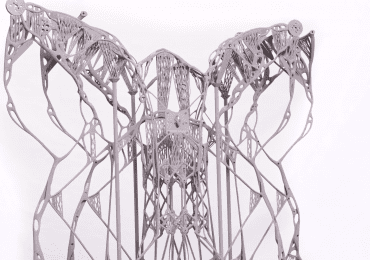
Aeroswift, a metal 3D printer development project backed by the South African government, has successfully completed the fabrication of a large scale component. Over half a meter tall, this titanium frame for a UAV was made to showcase the Aeroswift system’s capabilities.
The component made its first public appearance in 2018, but now the company has revealed details of how it worked with American software developer Altair to optimize the design.
Making of the world’s largest metal 3D printer
Founded in 2011, Aeroswift has the ambitious aim of developing and marketing the world’s largest metal 3D printer of its kind. Leveraging laser powder bed fusion (LPBF) technology, the Aeroswift system is reportedly capable of building parts up to 2m long, 0.6 m wide and 0.6 mm tall, at print speeds “up to ten times faster than other commercially available laser-based systems.” It is co-developed by specialists from aviation manufacturer Aerosud and the South African Council for Scientific and Industrial Research (CSIR)
The machine produced it’s first demo parts in 2016 and, by Spring 2017, it was producing proof of concept parts for airplane giants Boeing and Airbus.
Optimized 3D printing for aerospace
Occupying just a portion of the Aeroswift system’s potential volume, the dimensions of the latest UAV frame are 542 x 542 x 141 mm. To align with a specific set of requirements specified by the development team, Aeroswift design engineers employed Altair’s Inspire “simulation-driven” design software.
Aspects of the design specified by the team include the symmetrical placement of UAV motors, high stiffness to combat impact failure, a thrust-to-weight ratio of 2:5:1 across a flight time of 15 minutes, suitable dimensions and some aesthetic aspects. First, primitive volumes were used to outline the basic structure of the frame, then Altair Inspire was used to run a finite element analysis (FEA) of the design. After generating a baseline topology, the team then optimized features to ensure essential part connections were maintained. The finished piece is a lightweight, sturdy frame. According to Jacobus Prinsloo, Operations Manager at ADC Aeroswift, the team were “very pleased with the results.”
“Using Altair Inspire,” adds Prinsloo, “we could set up a process that helped us to achieve a topologically optimized UAV frame showing even better results than the benchmark.”
“WITHOUT ALTAIR AND THEIR TOOLS, WE WOULD NOT HAVE BEEN ABLE TO LEVERAGE THE FULL POTENTIAL OF ADDITIVE MANUFACTURING IN THE AEROSPACE INDUSTRY.”
Source: 3dprintingindustry
Building on their established successes in India and the USA, EOS and Phillips Machine Tools…
CPAC, a subsidiary of SCG, has entered into a significant partnership with SAMSUNG E&A to…
A research team from Graz University of Technology (TU Graz) in Austria has introduced two…
Aircraft maintenance plays a critical role in today's aviation industry, especially given the current challenges…
Calum Stewart Calum Stewart, a leading figure at SPEE3D, has been at the forefront of…
The Vice President of Rolf Mack at KraussMaffei talks about the future vision of Additive…
This website uses cookies.